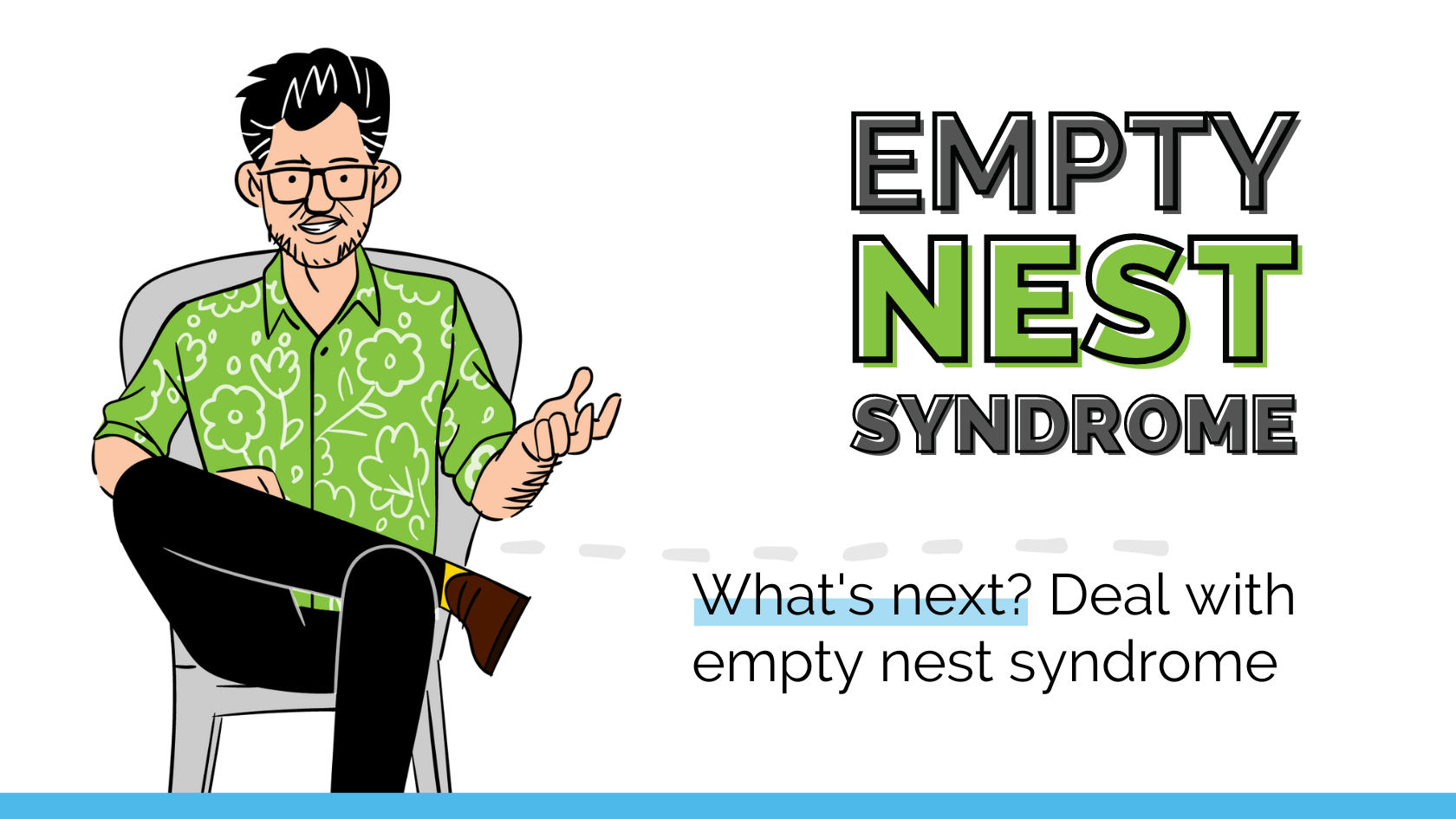By all accounts, raising a child is tough work – it’s also paradoxical. You should feel like you’ve summited your biggest mountain as a parent. But as your children venture into the world as adults, rather than the celebratory feeling of a job well done, it’s common to feel empty nest syndrome start to creep in.
You start thinking, “What’s next? I have a good four decades ahead of me, and I don’t want to spend it all playing golf. What am I going to do?”
I’ve got good news for you – that “what now” feeling isn’t something to be scared about. In fact, it’s a call to think big, strap on your hiking boots, search the horizon for a formidable peak, then start climbing.
I understand that this can be daunting – but the truth is that only when we’re doing hard stuff do we unlock our greatness.
Which means that now is the time to ask yourself – what’s the next big thing I want to commit to? What will this worthy goal be? And what’s the roadmap for achieving it?
What Is Empty Nest Syndrome?
Empty nest syndrome is a common experience of grief that occurs when your children move out of the family home.
It’s a significant milestone that can leave you feeling like your most important job has ended.
For all your uncertainty about the future, this transition is a beautiful opportunity for growth and self-discovery.
5 Ways to Start Your Empty Nest Adventure
While it’s natural to feel a sense of loss, these emotions are really a calling to step into something new. It’s a sign to set your sights on another worthy goal so that you can continue doing great work that changes the world.
Instead of doubting yourself, fearing you’ll make a mistake, and feeling like you need to play small so you don’t disrupt the status quo, start showing up for yourself so you can show up for the world. Here’s how:
1. Acknowledge and Embrace Your Feelings
Now, I’m in my fifties. While I don’t have children, a few years ago, I found myself in a parallel identity crisis with many of my peers who are parents.
I started a company 20 years ago called Box of Crayons.
The business grew amazingly, but I was never built to be a CEO. I’m a teacher. I’m good at creating. I’m good at having ideas. I’m good at being that translator who moves people from complexity to simplicity.
For 20 years, I had the identity of the guy who ran Box of Crayons. And for 20 or so years, you’ve had the identity of a parent. It’s discombobulating to lose that identity and shed skin you’ve worn tightly for so long. That’s how I felt when I stepped down from the company.
Like me, you may find yourself asking questions like: Who am I now? What am I doing? How do I show up in the world? What does my identity stand for if it’s no longer tied to this?
These are big, meaty, soul-searching questions that can feel overwhelming at first, but lean into them and use them to figure out more about who you are, and what you value, and chart a direction toward your worthy goal.
2. Be Fueled by Your Mortality
If you’ve read How to Begin, you’ll know my death date is September 14, 2043. And, of course, it may not be the actual day that I die (I’m kind of hoping it’s not because that’d be a bit too weird).
Really, what I’m talking about has to do with Kevin Kelly’s countdown clock – the day you expect to die.
It sounds morbid, I know, but it’s also a way of figuring out what you’re going to do with the time you have left.
Because even as we enter our 50s and 60s, a lot of us maintain this slight sense of immortality.
We can’t quite get our heads around the idea we’re going to die. But if you can turn it into a spiritual practice, you can look at the time you have left and use it as a source of internal motivation.
What are you going to do? How are you going to squeeze the juice out of every last bit of life? How can you make sure you’ve been the best version of yourself and had the impact you wanted?
Your death date can be a focusing moment, a force that pushes you into action, knowing that your time is finite and you must use it as best you can.
3. Write Your First Draft
Knowing all this, you can now start drafting your worthy goal – something I explore in depth in How to Begin. One mistake I often see people make is thinking that the first draft of their worthy goal is going to be their actual worthy goal.
They go, “Hey, this sounds pretty good and pretty exciting. Okay, let me try it.”
And when it doesn’t play out (as it so often doesn’t), they trace it back to the fact that they haven’t poked, prodded, and interrogated it and said, “Can I draft and redraft this to make it as strong as possible?”
And one of the ways to think about drafting and redrafting is through what I call the three P’s: projects, people, and patterns. Any worthy goal is likely to have all three of these.
Let me explain.
A project is about getting the thing done. It’s about how you get the dirt underneath your fingernails. How do you build a team, create a product, launch, stop, reinvent, whatever it might be for you?
Then there are people. Achieving a worthy goal is all about how you work with people in different ways. For some people, their worthy goal is about being a better boss, a better advocate, a better community citizen. It’s about how they show up in relationships in a different way.
Finally, there are patterns. I’m not talking about brightly colored tapestries. I’m talking about your behavior patterns, more specifically – how to break those patterns so that you can change the way you work. It’s about changing not just your doing but your being. And that is often a really worthy goal. You have to rewire yourself to think differently about yourself and about the world.
4. Weigh up the Risks and Rewards
Having named your worthy goal, you’ve got a choice – do or do not. Very Yoda-like.
So the first thing, and this is a counterintuitive act, is to imagine not doing it. Imagine walking away from this worthy goal. What are the prizes for walking away from it? What’s the punishment? What’s the benefit of not doing this, but what’s the cost to you and others for not doing this?
The benefit of not doing anything allows you to preserve the status quo. You don’t risk your reputation; you don’t have to bounce back from failure, you don’t risk others’ expectations of you, your time, or your money. You get to just keep things as they are.
And then you ask the same question in reverse, imagining you’ve fully committed to the worthy goal.
What are the prizes for that? What do I get from really taking this on? How do I benefit? How do I win? How do I seek glory? How do I feel good about myself? And how do I engage with others and make the world a bit better?
And finally, what’s the risk of fully committing? What is the cost of you taking this on and what happens if you fail?
Because with a worthy goal, something that is daunting, there’s no guarantee of success.
5. Don’t Travel Alone
No one does anything important alone – and the same goes for you and your worthy goal. When the kids leave the house, you need human connection, not isolation. So bringing people together around your next big thing is a win-win.
But that doesn’t mean you should travel with just anyone – rather, there are five archetypes and associated energies that you want in your band.
The five energy archetypes are associated with five different directions:
- First, you have the warrior energy. This is a sense of fierceness and pushback against resistance. It’s about stepping forward and holding the line.
- The second is the healer or the lover. This is a place of comfort, rejuvenation, messiness, and safety. It’s a gentle and sanctuary-like energy that provides solace and support. Sometimes, you need that gentleness and that place of sanctuary.
- The third is the teacher’s energy. This is the hunger for knowledge and the willingness to sit at somebody’s feet and learn. It’s about being open and eager for the lessons that will expand your understanding.
- The fourth is the ruler or the visionary. This is about ambition and holding the bigger picture. It requires a degree of ruthlessness to determine what needs to be done to achieve the vision. It’s about taking charge and leading the way.
- Finally, you’ve got the Trickster energy. This is the person who teases you, challenges you and tries to distract you. It’s like the shapeshifter, the jackal, or the raven in myth. I have found it helpful to reframe some of the resistance that I sometimes get from myself or others as trickster energy. It prompts me to ask, “How is this helping me?” It allows me to get clearer and bolder about the journey that I’m on.
Your five archetypes don’t have to be five different people. You may find you relate to one or two of these energies yourself and lean on a couple of other people to provide you with the other two or three.
Life Is Fleeting: Squeeze the Lemon
Empty nest syndrome is an inner calling to find your worthy goal. The time to act is now.
Find something that inspires you, stretches you, lights you up, and gives more to the world than it takes.
And if you need a helping hand along the way, the How to Begin online course is a structured, powerful way to deeply engage in your most meaningful work.

